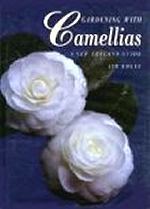
|
Gardening
with Camellias By Jim Rolfe Reviewed by Val Bieleski This beautifully illustrated book is both a history, detailing how the genus Camellia spread to the western world, and a useful guide to the interested grower, with detailed instructions on the cultivation and care of these versatile plants. In recent years the camellia has become a popular garden plant, its appeal being intensified as selection and hybridisation have further enlarged the range of plants available. Very few books have been available of recent years to help the amateur with information on the care of camellias, and this book is a welcome addition to their ranks. The 175 colour photographs of excellent quality serve not only for the purposes of identification for the interested buyer, but also show to great effect the many uses camellias can be put to in landscaping. Most of the photos, including a superb cover photo of C. japonica 'Fimbriata', were taken by Yvonne Cave FPSNZ and provide the quality of illustration that defines some garden books as 'coffee table books'. In this case, however, the illustrations are combined with a knowledgeable text to make an extremely useful and comprehensive guide of both practical and aesthetic value. The first chapter of the book discusses the genus and its subdivision into over 250 identified species. Within the species there is much natural variation and new species, are still being discovered, all of which adds to the versatility and wonderful breeding opportunities available to hybridists. The history of camellia domestication is then detailed, from the origins of the genus in China, Japan, and South-east Asia, along with its subsequent spread to the Western world. New Zealand is fortunate in having excellent climatic conditions for growing camellias, and a considerable number of skilled hybridists. Cultivars from New Zealand have met with great acclaim overseas, both for garden merit and on the show bench. The author then provides a helpful guide to growers on how to select the plants they desire on the basis of six characteristics — size, form, colour, flowering season, foliage and growth habit. Useful charts, such as that detailing growth habits will be very helpful to the novice grower who seeks a camellia for a specific situation. These charts are in each case well illustrated, and I consider them a very valuable feature of the book. The chapter on growing camellias in the open ground discusses the wide range of situations where planting a camellia can be a useful solution to a landscaping problem as well as providing great pleasure as a beautiful object in its own right. The versatility of a plant that can be utilised for hedging, espaliering, ground cover, standards, as a specimen plant, or mingling with other plants in the shrubbery is well brought out in the discussion. The charts provided give useful examples for each type covering this vast range. Container growing is an area of ever-increasing popularity, helped by the great range of small leafed, small flowered and scented cultivars now being released by nurseries. The material in this chapter is covered in great detail, and will be very useful to those seeking information on patio planting or on providing interest in small enclosed areas. Jim Rolfe's many years of experience in camellia growing are well displayed in the detailed section on propagation. Methods are clearly illustrated by line drawings and photographs. The range of methods open to the propagator, including cuttings, air layering, and different ways of grafting, are explained clearly and simply. Pests and diseases are covered in a general fashion. Perhaps as this is a New Zealand guide more specific details could be given of preventive treatments available in this country. Once again the photographs used give graphic details of insect pests that enjoy camellias in their diet although the example given of leafroller caterpillar would appear to be a caterpillar of the white butterfly, not generally considered a great problem by the camellia grower. A lengthy list covering eleven pages has also been included giving details of 400 camellia species and cultivars. I am not altogether sure of the value of this, which is the author's choice from the 30,000 camellias registered in the official nomenclature. Even in New Zealand, not all camellias grow well in all areas, and of course the buyer is always going to be restricted by availability. Some of those mentioned would be very difficult if not impossible to obtain. Horticulture in New Zealand: Journal of the Royal New Zealand Institute of Horticulture 1992 3(2): 21 |
Home | Journal
| Newsletter | Conferences
Awards | Join
RNZIH | RNZIH Directory | Links
© 2000–2026 Royal New Zealand Institute of Horticulture
Last updated: January 24, 2005

 BOOK
REVIEWS
BOOK
REVIEWS